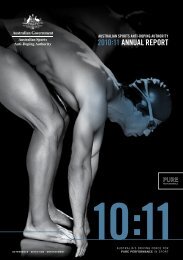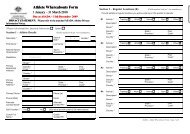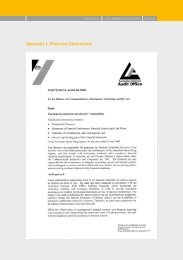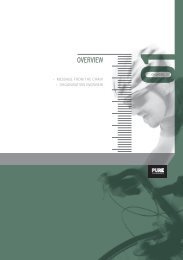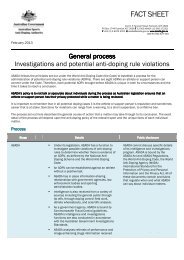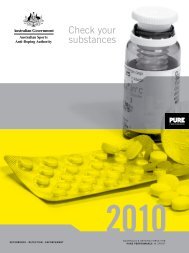PDF - 3MB - Australian Sports Anti-Doping Authority
PDF - 3MB - Australian Sports Anti-Doping Authority
PDF - 3MB - Australian Sports Anti-Doping Authority
Create successful ePaper yourself
Turn your PDF publications into a flip-book with our unique Google optimized e-Paper software.
eaches that issue, it is required that what French admits to using, Testicomp,<br />
must first be proven to have within in it the prohibited substance and second he<br />
must be shown to have used it.<br />
48. It is a basic element of possession that there must be a finding of fact as to the<br />
specific material "possessed" by French and that it contain the<br />
glucocorticosteroid . The CAS Oceania case ofAOC v. Eadie4 is directly on point.<br />
Eadie was alleged to have trafficked a prohibited substance by importing it into<br />
Australia . The imported package was either destroyed or returned to sender and<br />
accordingly, tests of its contents were unable to be undertaken. In those<br />
circumstances , the Hon. Justice Cripps in his capacity as an Arbitrator stated at<br />
paragraph 32 on p. 8 of his award:<br />
"Beyond knowing that someone in Customs Service said<br />
that the parcel in January 1999 included in it tablets<br />
`containing APP [anterior pituitary peptide, a prohibited<br />
substance] that is all that I know about the substance ".<br />
and further on at paragraph 37 on p . 10 of his award:<br />
"The plinth upon which the case against Mr. Eadie<br />
rests is the assumption that, the Court should<br />
conclude that the untested and unanalysed tablets in<br />
fact contained APP ".<br />
Justice Cripps went on to say that Eadie was not shown to have been untruthful<br />
and applied the standard of proof identified in Briginshaw v. Briginshaw, supra,<br />
to hold that he was not satisfied that in January 1999 Eadie imported a prohibited<br />
substance into Australia<br />
49. It is the submission of the Appellant that the fact a label on a container states that<br />
the substance in the container is or contains a prohibited substance, does not of<br />
itself prove that the substance in the container actually is or actually contains a<br />
prohibited substance, nor does it relieve the Respondents of their responsibility to<br />
do so. The Respondents submit that it is not helpful to look at criminal law for<br />
the analysis. Rather the inquiry should be one of what the contract provided for<br />
and the commercial context of the contract in relation to what the parties were<br />
agreeing to do. It is a further submission of the Respondents that the admission of<br />
the use of the Testicomp, which lists Cortisonacetat Dil (a glucocorticosteroid) as<br />
an ingredient, is an admission of a breach of the policy and the Panel should find<br />
that the breach is established. For the reasons set out below the Panel accepts the<br />
submission of the Appellant.<br />
y<br />
50. French in his statement admits injecting Testicomp thereby establishing "use".<br />
But what is it that he actually used? A laboratory analysis for<br />
event; (h) would probably be too difficult to prove and therefore would open the floodgates to drugs cheats;<br />
and (c)ould certainly be too expensive to prove. See also generally ,4 v. FILA (CAS 2001/A/317), L v.<br />
FINA (LAS 95/142), ,4 C v. FINA (CAS 96/ 149), Bernhard v. 1T U (CAS 98/222), Raducan v. IOC (CAS<br />
OG00/011), C v. FINA (CAS 95/141).<br />
(A4/2004) Partial Award 21 July 2004. The individual involved in that case was a witness in this appeal.<br />
12





